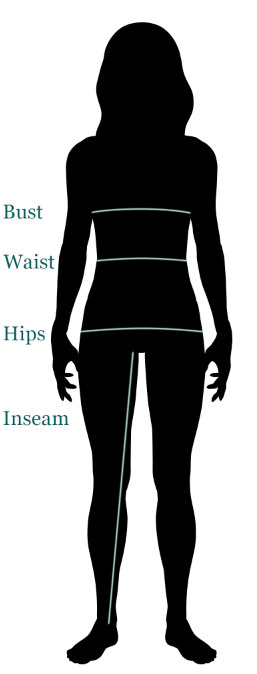If you’re into online shopping, knowing your body measurements is a necessity to getting clothes in the right sizes. J.Crew sizing is different from H&M sizing, and retailers can even be inconsistent across their own line. Sizing inconsistencies can be attributed to different fabrics, updated cuts of products bearing the same name, and even vanity sizing.
When taking your measurements, be sure to use a cloth measuring tape (or other options that we recommend in the absence of one) — not a metal measuring tape. This will ensure that you’re measuring your body accurately. In addition, measure only over bare skin or skin-tight clothes so as to ensure the most accurate measurements.
What You Should Measure
Chest or Bust
This measurement is used for tops and dresses.
Women: Place one end of the tape measure at the fullest part of your bust and wrap it around your body to get the measurement, keeping the tape parallel to the floor.
Men and kids: Place one end of the tape measure at the center of your chest. Wrap it around your body, keeping the tape parallel to the floor.
Bra Sizing
Bras are sized using a unique system based on two measurements of the bust area. For detailed instructions on how to measure to determine bra size and get a correct fit, please see: How to Measure for a Bra.
Waist
This measurement is used for tops, dresses, and bottoms.
Most clothing lines use the measurement of the “natural waist” for their size guides. To measure your natural waist, you want to find the narrowest part of your waist, located above your belly button and below your rib cage.
Note some brands use a “low” waist measurement. For this, you would measure at the point where your trousers would normally ride.
Hips
This measurement is used for bottoms and sometimes for dresses.
Stand with your hips together and measure the fullest part of your hips. Be sure to go over your buttocks as well. It might be challenging to keep the tape consistently level when you do it alone; it is recommended that you have a friend assist you with this or that you do it in front of a mirror.
Inseam
This measurement is used for trousers and jeans.
The inseam is the distance from the uppermost part of your thigh to your ankle. It is easiest to measure the inseam based on a well-fitting pair of pants. Measure from the crotch to the cuff on the inside seam of the leg. The number of inches, to the nearest ½”, is the inseam length. It’s best to measure your inseam with a pair of shoes on so that you can ensure the hem hits at the right point on your shoe.
For women, keep in mind that the accurate inseam measurement depends on whether you’re wearing heels or flats. The hem should hit at the middle of the heel shaft or should hit just slightly above the flat shoe. It would be best for women to take two measurements for inseams — one for trousers you’d wear with heels, and one for trousers you’d wear with flats.
Neck measurement
Neck measurement is commonly used for sizing men’s dress shirts. Many dress shirts sold in the U.S. actually use the neck size in inches as the “size.”
Wrap the measuring tape around the base of your neck, going around your Adam’s apple. Ensure that the tape is consistently level and that you’re not wrapping the tape too tightly around your neck. This measurement is your true neck measurement. For your dress shirt neck measurement, add a half inch to a round number (i.e. 14 inches should be rounded up to 14.5 inches) or round up to the nearest half inch (i.e. 14.25 should be rounded up to 14.5).
Sleeve measurement
Sleeve measurement is often used for sizing men’s dress shirts.
You will need a friend to assist you for measuring sleeve length. Bend one arm at a 90 degree angle and place your hand on your hip. Have a friend measure from the center of your back, across your shoulder, down to your elbow and then to your wrist for your full sleeve measurement. Most sleeve measurements fall between 32 and 39 inches. Sleeve sizes are always in whole numbers; round up to the nearest whole number if needed.
How Measurements Correspond to Sizes
The first thing to look for when online shopping is the size chart. Clothing manufacturers will lay out bust, waist, and hips measurements in inches or centimeters that correspond to sizes. Each brand or designer uses a different scale, so it’s best to check the measurements on which that brand bases its sizing.
Taking Time to Measure Can Make Shopping More Successful
Having your measurements ensures that you will know the best size to get for your clothes. It is an easy way to take much of the risk out of online shopping, and can be helpful if you’re looking at doing alterations to your clothes as well.


